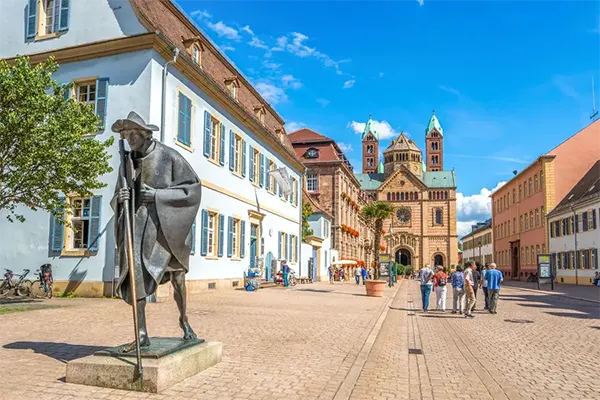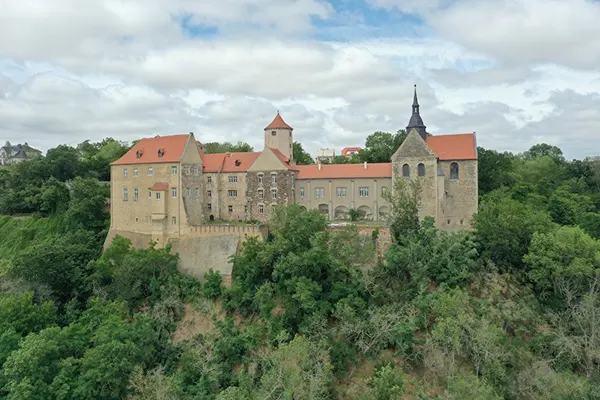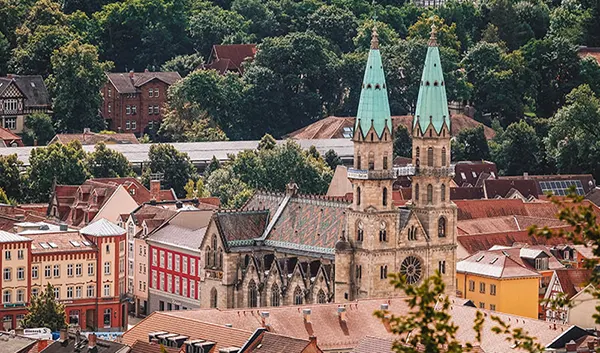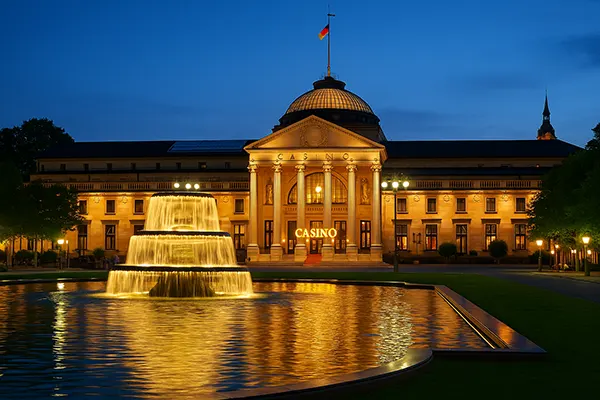
Speyer: Gothic Undergrounds and One of Europe’s Oldest Cathedrals
Located on the banks of the Rhine in Rhineland-Palatinate, Speyer is a city where medieval history intertwines with unique architectural and technological heritage. It stands out in the popular niche of historical tourism linked to bunkers, catacombs, and underground crypts, attracting curious travellers interested in Europe’s layered past. The city’s highlights are not only visible above ground — much of its true character lies beneath the surface.
Imperial Cathedral and Its Romanesque Crypt
The Speyer Cathedral (Kaiserdom zu Speyer) is a monumental structure, considered one of the most significant Romanesque buildings in Europe. Completed in the 11th century, it served as the burial site for eight emperors and kings of the Holy Roman Empire. Its massive sandstone walls and round-arched design convey both authority and sacred dignity.
What truly fascinates visitors is the crypt — the oldest part of the cathedral, dating back to 1030. This underground space, supported by robust columns and Romanesque arches, is exceptionally well-preserved and functions as the final resting place of imperial figures such as Emperor Conrad II. The atmosphere in the crypt is solemn and timeless, reinforcing Speyer’s importance in imperial history.
The cathedral has been a UNESCO World Heritage Site since 1981, recognised for its architectural harmony and historical relevance. Restoration efforts ensure that its unique underground sections remain accessible and structurally sound, offering visitors a glimpse into medieval funerary culture.
Exploring the Crypt: Historical Significance and Preservation
Descending into the Speyer crypt is like entering the foundation of Western Christian tradition. The crypt’s purpose was both practical and symbolic: to honour rulers and anchor the power of the empire within a sacred site. Its symmetry and austere beauty make it a rare example of early medieval burial architecture.
Modern conservation methods have kept the crypt stable without altering its original design. Lighting is subtle to preserve the authenticity, while informative panels guide visitors through the stories of those buried there. The atmosphere reflects both reverence and historical curiosity.
For historians and architects, the crypt represents a cornerstone of Romanesque design in northern Europe. Its craftsmanship influenced the development of sacred spaces in later centuries, making it a reference point for studies on medieval construction and imperial iconography.
Speyer’s Technology Museum and the U9 Submarine
Outside the historical core, the Technik Museum Speyer brings a completely different perspective to the city’s offerings. Opened in 1991, it houses one of Europe’s most diverse collections of technological marvels — from vintage cars and aircraft to a full-scale Russian Buran space shuttle and the German U9 submarine.
The U9 submarine, accessible to visitors, is a rare opportunity to experience life aboard a military vessel. Commissioned in 1967 and retired in 1993, it served the Bundesmarine during the Cold War. Its narrow corridors, torpedo rooms, and diesel-electric engines reflect the intense operational demands faced by German naval forces.
This contrast between sacred architecture and military technology underlines Speyer’s diversity. The museum caters not only to families and tech enthusiasts, but also to researchers and veterans who seek accurate preservation of 20th-century defence history.
Inside the U9 Submarine: Living Conditions and Technical Detail
Visitors can step directly into the control room of the U9, where sonar equipment and navigation tools are still intact. Labels and diagrams explain the sub’s propulsion systems and daily routines of its crew. The preserved instruments offer an authentic, immersive experience unlike any virtual simulation.
Life aboard the U9 was challenging: tight spaces, constant vigilance, and minimal comfort. Original sleeping bunks, periscopes, and torpedo tubes remain in place, telling a story of endurance and technological innovation. For children and adults alike, it’s a lesson in history that can be touched and explored firsthand.
Technical accuracy is a priority in the museum’s curation. The U9 has undergone only minimal modification to meet safety requirements, ensuring that the exhibit remains faithful to its operational past. It is now a symbol of Speyer’s commitment to preserving not only ancient history but also recent milestones in engineering.

Old Town Beer Cellars and Medieval Brewing
Beyond churches and museums, Speyer’s underground world continues in the vaulted beer cellars beneath the old town. These spaces were crucial in the fermentation and storage processes of medieval brewing — a craft deeply rooted in the city’s culture. They were used year-round, providing stable temperatures and protection from spoilage.
Many of these cellars are now integrated into restaurants and cultural venues, where visitors can dine or taste local brews while surrounded by centuries-old stone architecture. Some cellars still display original brewing tools, wooden barrels, and ventilation ducts that tell stories of Speyer’s trade traditions.
Guided tours organised by local historians provide access to less-known cellars that are not usually open to the public. These tours combine anecdotes about beer-making with architectural insights, illustrating how underground structures helped shape the economic and social rhythm of medieval Speyer.
Cellar Culture: From Preservation to Public Events
In the last decade, Speyer has revitalised many of its historic beer cellars through community projects and cultural grants. Several venues now host jazz evenings, literary readings, and craft beer festivals in these subterranean spaces. The ambience — cool, quiet, steeped in history — offers a perfect setting for cultural enrichment.
Local brewers often use these events to reconnect with ancient methods, offering tastings of ales brewed according to medieval recipes. The blend of heritage and modern creativity adds a new layer to Speyer’s underground identity, far beyond its religious and military past.
Some cellars have been digitally mapped and made accessible via 3D virtual tours, expanding Speyer’s reach to those unable to visit physically. These initiatives reflect the city’s dedication to keeping its underground legacy not only preserved but continually evolving with the times.



